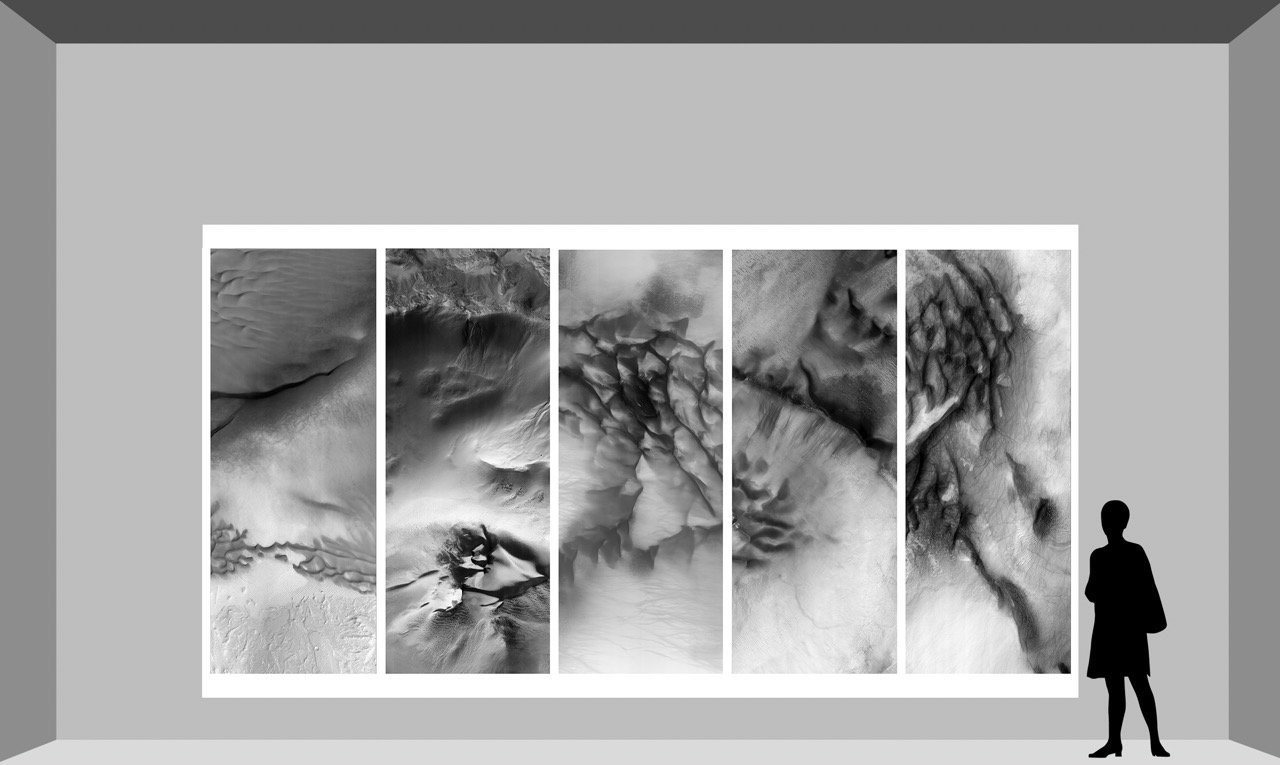















Your Custom Text Here
Like the Mars Topographies (2017-2018), Mars Suites are composed of images downloaded from the Mars Reconnaissance Orbiter mission, 2006 – present. This has produced an enormous quantity of extremely high resolution images of the Martian landscape (80,000 and counting).
The Orbiter mission circles and records all areas of Mars, essentially looking for signs of water, valuable minerals, and possible landing sites. Most areas are photographed again and again in different lighting and weather situations, much like an earthbound photographer will visit a site multiple times to photograph it in changing conditions.
Similar, although unusual landforms are found in disparate locations around the planet and most of the Mars Suites bring these areas together to compose one photograph.
The landmass captured in each panel in the photograph is roughly five kilometers wide by 10 to 12 kilometers long.
– EZ, 2019
Mars Suites are published in two formats as archival inkjet prints, each in an edition of 5. One size is typically 54”h x 40 w. A larger size can be printed up to 10’ tall by corresponding width.
Source Material: NASA/JPL/University of Arizona
Like the Mars Topographies (2017-2018), Mars Suites are composed of images downloaded from the Mars Reconnaissance Orbiter mission, 2006 – present. This has produced an enormous quantity of extremely high resolution images of the Martian landscape (80,000 and counting).
The Orbiter mission circles and records all areas of Mars, essentially looking for signs of water, valuable minerals, and possible landing sites. Most areas are photographed again and again in different lighting and weather situations, much like an earthbound photographer will visit a site multiple times to photograph it in changing conditions.
Similar, although unusual landforms are found in disparate locations around the planet and most of the Mars Suites bring these areas together to compose one photograph.
The landmass captured in each panel in the photograph is roughly five kilometers wide by 10 to 12 kilometers long.
– EZ, 2019
Mars Suites are published in two formats as archival inkjet prints, each in an edition of 5. One size is typically 54”h x 40 w. A larger size can be printed up to 10’ tall by corresponding width.
Source Material: NASA/JPL/University of Arizona
Suite 134, 2019, archival pigment print, 42” x 40”
Suite 125, 2019, archival pigment print, 54” x 40”
Suite 18, 2018, archival pigment print, 54” x 40”
Suite 32, 2019, each panel maximum 120”h x 36”w
Suite 45, 2018, archival pigment print, 42” x 40”
Suite 100, 2018, archival pigment print, 42” x 40”
Suite 97, 2019 archival pigment print, 42” x 40”
Suite 40, 2019, each panel maximum 120”h x 36”w
Suite 14, 2018, archival pigment print, 42” x 40”
Suite 108, 2019, archival pigment print, 42” x 40”
Suite 3, 2018, archival pigment print, 54” x 40”
Suite 130, 2019, archival pigment print, 54” x 40”
Suite 113, 2019, each panel maximum 120”h x 36”w